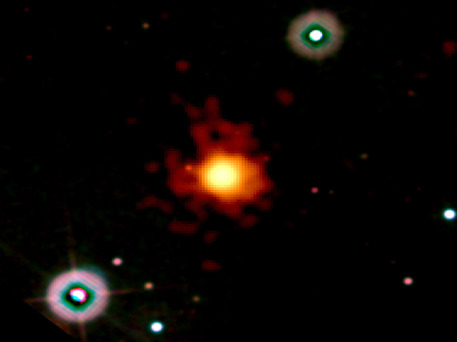Gamma-ray burst 13.1 billion light years away
"More about gamma-ray bursts"
 © NASA/Swift/Stefan Immler
|
This image merges data from Swift's Ultraviolet/Optical (blue, green) and X-Ray (orange, red) telescopes. No visible light accompanied the burst, which hints at great distance. The image is 6.3 arcminutes wide.
Gamma-ray bursts are discovered by telescopes in space. After releasing their intense burst of high-energy radiation, they become detectable for a short while in the optical and in the near-infrared. This ‘afterglow’ fades very rapidly, making detailed analysis possible for only a few hours after the gamma-ray detection. This analysis is important in particular in order to determine the GRB's distance and, hence, intrinsic brightness.
Gamma-ray bursts are the universe's most luminous explosions. Most occur when massive stars run out of nuclear fuel. As their cores collapse into a black hole or neutron star, gas jets - driven by processes not fully understood - punch through the star and blast into space. There, they strike gas previously shed by the star and heat it, which generates short-lived afterglows in many wavelengths.
The gamma-ray burst detected last week was easily identified to be special as explained by team member Edo Berger of Harvard University: "The lack of visible light alone suggested this could be a very distant object."
Beyond a certain distance, the expansion of the universe shifts all optical emission into longer infrared wavelengths. While a star's ultraviolet light could be similarly shifted into the visible region, ultraviolet-absorbing hydrogen gas grows thicker at earlier times. "If you look far enough away, you can't see visible light from any object," he noted.
ESO/NASA
Gamma-ray bursts are the universe's most luminous explosions. Most occur when massive stars run out of nuclear fuel. As their cores collapse into a black hole or neutron star, gas jets - driven by processes not fully understood - punch through the star and blast into space. There, they strike gas previously shed by the star and heat it, which generates short-lived afterglows in many wavelengths.
The gamma-ray burst detected last week was easily identified to be special as explained by team member Edo Berger of Harvard University: "The lack of visible light alone suggested this could be a very distant object."
Beyond a certain distance, the expansion of the universe shifts all optical emission into longer infrared wavelengths. While a star's ultraviolet light could be similarly shifted into the visible region, ultraviolet-absorbing hydrogen gas grows thicker at earlier times. "If you look far enough away, you can't see visible light from any object," he noted.
ESO/NASA
Gamma-ray burst 13.1 billion light years away
"More about gamma-ray bursts"
 © NASA/Swift/Stefan Immler
|
This image merges data from Swift's Ultraviolet/Optical (blue, green) and X-Ray (orange, red) telescopes. No visible light accompanied the burst, which hints at great distance. The image is 6.3 arcminutes wide.
Gamma-ray bursts are discovered by telescopes in space. After releasing their intense burst of high-energy radiation, they become detectable for a short while in the optical and in the near-infrared. This ‘afterglow’ fades very rapidly, making detailed analysis possible for only a few hours after the gamma-ray detection. This analysis is important in particular in order to determine the GRB's distance and, hence, intrinsic brightness.
Gamma-ray bursts are the universe's most luminous explosions. Most occur when massive stars run out of nuclear fuel. As their cores collapse into a black hole or neutron star, gas jets - driven by processes not fully understood - punch through the star and blast into space. There, they strike gas previously shed by the star and heat it, which generates short-lived afterglows in many wavelengths.
The gamma-ray burst detected last week was easily identified to be special as explained by team member Edo Berger of Harvard University: "The lack of visible light alone suggested this could be a very distant object."
Beyond a certain distance, the expansion of the universe shifts all optical emission into longer infrared wavelengths. While a star's ultraviolet light could be similarly shifted into the visible region, ultraviolet-absorbing hydrogen gas grows thicker at earlier times. "If you look far enough away, you can't see visible light from any object," he noted.
ESO/NASA
Gamma-ray bursts are the universe's most luminous explosions. Most occur when massive stars run out of nuclear fuel. As their cores collapse into a black hole or neutron star, gas jets - driven by processes not fully understood - punch through the star and blast into space. There, they strike gas previously shed by the star and heat it, which generates short-lived afterglows in many wavelengths.
The gamma-ray burst detected last week was easily identified to be special as explained by team member Edo Berger of Harvard University: "The lack of visible light alone suggested this could be a very distant object."
Beyond a certain distance, the expansion of the universe shifts all optical emission into longer infrared wavelengths. While a star's ultraviolet light could be similarly shifted into the visible region, ultraviolet-absorbing hydrogen gas grows thicker at earlier times. "If you look far enough away, you can't see visible light from any object," he noted.
ESO/NASA





